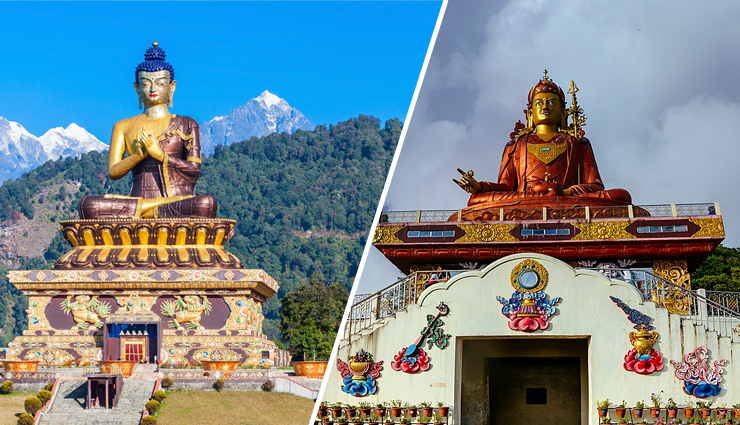5 Unique Historical Monuments To Explore In Sikkim
By: Priyanka Maheshwari Tue, 12 Sept 2023 10:33:50

If you're in search of a destination brimming with a profound history, spirituality, and a distinctive culture, look no further than Sikkim, one of India's renowned holiday getaways. Nestled in the northeastern part of the country, this charming state boasts not only a wealth of natural beauty and majestic mountains but also a plethora of tourist attractions that transport you to a bygone era, providing a truly immersive experience.
These sites are renowned for their ability to vividly portray Sikkim's rich cultural heritage and historical legacy. Within the state, there are numerous opportunities to engage in meditation and partake in various activities alongside the local populace.
In essence, Sikkim's historical monuments encompass a wide spectrum, from their religious significance to their deep-rooted historical narratives, offering a comprehensive and awe-inspiring experience to all who visit. Therefore, it's time to take a well-deserved vacation in the enchanting realm of Sikkim, where you can acquire a unique and authentic education that remains unparalleled in any other part of India.

# Rabdentse Ruins
This particular tourist destination possesses a distinctive allure, consistently earning a top spot on the list of the finest monuments in Sikkim. These remnants encompass a captivating lake and expansive grounds, inviting leisurely strolls while soaking in their beauty. From this vantage point, you can savor breathtaking vistas of the lush forests and undulating hills surrounding Pelling.
Furthermore, the presence of chestnut trees adds to the picturesque scenery, providing a visual feast that's certainly worth capturing with your camera. A visit to this site serves as a captivating journey through time, offering valuable insights into the illustrious history of this location.
Reasons to explore Rabdentse Ruins: According to historical records, Rabdentse once served as the second capital of the former Kingdom of Sikkim. Consequently, a visit to these ruins allows you to delve into the annals of history, relishing the moment while creating cherished new memories.

# Rumtek Monastery
Nestled atop a hill, commanding panoramic views of Gangtok, the Rumtek Monastery stands as one of Sikkim's most significant and largest monastic establishments. Embarking on a spiritual journey here allows one to delve into a realm of tranquility and inner peace. This monastery, also known as the Dharma Chakra Centre, has its origins dating back to the 16th century.
Rumtek Monastery stands out as a remarkable example of traditional architectural design, securing its place among the most renowned monastic sites in Sikkim. Within its sacred precincts, numerous captivating elements await your attention, including a resplendent golden stupa and an array of sculptures hailing from the era of the 16th Karmapa.

# Dubdi Monastery
Dubdi Monastery, also known as the Hermit's Cell Monastery, is a revered and historic religious site located in the picturesque state of Sikkim, India. Dubdi Monastery is situated on a hilltop in the western part of Sikkim, near the charming town of Yuksom. It is part of the Yuksom-Dzongri Trekking Circuit, making it accessible to trekkers and nature enthusiasts. Dubdi Monastery holds great historical importance as it is one of the oldest monasteries in Sikkim. It was established in 1701 by the third Chogyal (monarch) of Sikkim, Chogyal Chakdor Namgyal. The monastery was built to promote Buddhism in the region and has served as a sacred center for Buddhist learning and meditation for centuries.
The name "Dubdi" translates to "the retreat," reflecting the monastery's purpose as a hermit's cell for meditation and spiritual practice. It was originally intended for the exclusive use of the lamas (Buddhist monks) for their solitary retreats. Dubdi Monastery is known for its traditional Tibetan architectural style, characterized by intricate woodwork, vibrant frescoes, and beautifully carved doorways. The main prayer hall houses ancient scriptures, thangka paintings, and religious artifacts.

# Pemayangtse Monastery
Pemayangtse Monastery is a revered Buddhist monastery located in the Indian state of Sikkim. The monastery was founded in 1705 by Lama Lhatsun Chempo, one of the revered Lamas of Tibetan Buddhism. Pemayangtse translates to "Perfect Sublime Lotus," reflecting the spiritual aspirations of the monastery.
Pemayangtse is renowned for its exquisite architecture and intricate woodwork. The monastery follows the Nyingma sect of Tibetan Buddhism and houses numerous ancient Buddhist scriptures, religious artifacts, and intricately painted thangka scrolls. The main prayer hall is adorned with colorful frescoes and intricate murals depicting Buddhist deities and legends.
Pemayangtse Monastery is a significant center for the study and practice of Vajrayana Buddhism. It has played a crucial role in preserving and propagating Buddhist teachings and rituals in the region. The monastery also serves as the main seat of the Pemayangtse Sangh, a monastic community.

# Coronation Throne of Norbugang
The Coronation Throne of Norbugang, also known as the "Throne of Norbugang," is a historically significant site located in the charming town of Yuksom in the Indian state of Sikkim. This site holds great importance in the history and culture of Sikkim and is associated with the establishment of the first Chogyal (monarch) of Sikkim.
In addition to the tree, there is also a stone platform called the "Norbugang Stone" at the site. This stone is believed to have been used during the coronation ceremony as a symbolic throne where Phuntsog Namgyal was anointed as the ruler of Sikkim. The Coronation Throne holds spiritual significance, as it marks the beginning of the Namgyal dynasty's rule in Sikkim and the spread of Buddhism in the region. The first Chogyal's coronation was conducted with Buddhist rituals and blessings.





